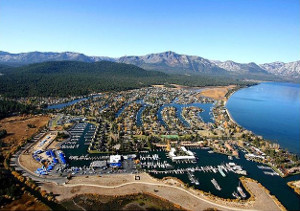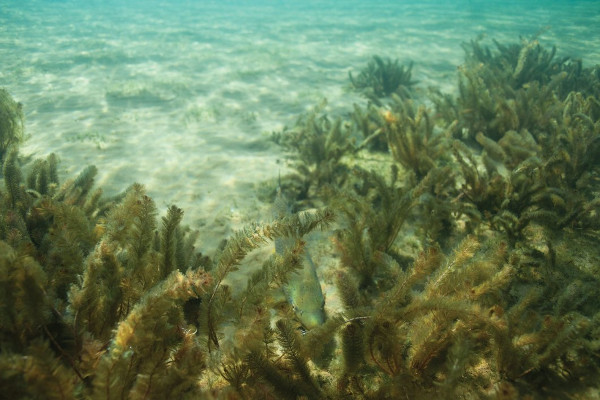
Update November 12, 2021
On November 1, the Sierra Club Tahoe Area Group submitted these comments in response to the Lahontan Water Quality Board's consideration of a permit to allow the use of herbicides to control aquatic invasive weeds overwhelming the Tahoe Keys lagoons. The Lahontan board will decide whether to move forward with the permit (and the poisoning) at their board meeting in January.
Original blog post July 11, 2019
Arguably the worst thing ever to happen to Lake Tahoe was the Tahoe Keys housing development and marina, built at the mouth of the Upper Truckee River in South Lake Tahoe in the 1960s.
Lake Tahoe’s largest wetland, purifying the largest tributary of the lake, and providing beauty and wildlife habitat, was dredged and bulldozed to build a 740-acre, 1500-home development (with nearly as many boat docks). Now the Tahoe Keys development and marina have become infested with invasive aquatic weeds that threaten all of Lake Tahoe.

Eurasion milfoil (Myriophyllum spicatum) is a true invader and survivor. Although it can reproduce by seeds, its broken fragments re-sprout independently. Propellers from hundreds of boats slice it up and spread it throughout the Lake.
The Tahoe Regional Planning Agency and Lahontan Water Quality Control Board are looking for solutions by testing a series of control methods, including the use of herbicides. They have opened up the comment period for the Notice of Preparation (NOP) for Tahoe Keys Lagoons Aquatic Weed Control Methods Test. They are seeking public comments on (1) methods of removal, both those that are proposed (including herbicides) and suggestions for methods not proposed, and (2) alternative selection criteria.
Sierra Club believes the herbicides also threaten the purity and ecology of the lake; no herbicides should be used until other natural methods are proven inadequate. Herbicides have not been used in Lake Tahoe before and have failed elsewhere. There are a number of other natural methods that are more promising and realistic than threatening the water quality and safety.
Sign Sierra Club’s petition here
This is a critical time to comment if we want these agencies to include other methods and alternatives in the EIR/EIS than those proposed. If those comments are not provided, they may not include them in the environmental analysis.
A few important facts:
1) The Tahoe Keys were once a marsh and were allowed to be built before environmental regulations were in effect. This project would not be allowed to be built today.
2) The Tahoe Keys lagoons flow directly into Lake Tahoe and are the source of aquatic invasive weeds that are now showing up regularly around the entire lake, including the north shore. Because of continued spread of these weeds throughout the lake, Sierra Club is concerned that herbicide use in the lagoons will lead to herbicide use throughout the lake ecosystem to control the weeds.
3) The Tahoe Keys Property Owners Association (TKPOA), has proposed to treat the weeds with herbicides. TKPOA has spent a lot of money to convince decision-makers this would be the best option.
4) The current alternatives are (1) no project, and (2) use 18 test sites in the lagoons to perform treatment methods such as aquatic herbicides, UV-C light, bottom barriers, and hand pulling. Sierra Club believes a third alternative be considered: restoring the Tahoe Keys' lagoons to marshland (owners wouldn't be able to pull boats right to their houses anymore, but they would be able to enjoy wildlife and wetlands, instead of boats and weeds. We believe everyone needs to acknowledge that the source of this problem is the Tahoe Keys development itself. Invasive weeds will be an on-going problem and expense until the source of the problem—the Keys—is confronted head on. Lake Tahoe and its fragile ecosystem should not have to suffer continued bad decisions (both weeds and widespread pesticide use) to manage this problem.
5) The EPA classifies Lake Tahoe as an Outstanding National Resource Water (ONRW) or Tier III water, of which there are only two in California: Mono Lake and Lake Tahoe. There are only a few others around the country. The EPA requires that water quality for all ONRWs must be maintained without exception (i.e., not allowed to degrade). Allowing pesticides could degrade Tahoe’s water quality.
Sierra Club believes that herbicides should be a last resort; that all other control methods (UV mats, hand pulling, and other technologies) need to be exhausted (even if more expensive) before herbicides are considered. Herbicides have not been used in Lake Tahoe before and have failed elsewhere.
6) We believe the Tahoe Keys community needs to bear the full cost of treatment for these weeds. They are the cause of this problem, and the public should not have to pay for their mistakes. $3.7 million have been spent to date on weed management (not including harvesting). The dollars spent on the NOP and EIR/EIS will not be spent only by Tahoe Keys Home Owners Association, but by the entire community. These dollars could be spent on lake-wide environmental improvement projects that are not caused by one man-made problem.
7) Sierra Club policies on this issue:
-
Sierra Club supports the Precautionary Principle: “When an activity potentially threatens human health or the environment, the proponent of the activity, rather than the public, should bear the burden of proof as to the harmlessness of the activity. Where there are threats of serious or irreversible damage, lack of full scientific certainty shall not be used as a reason for postponing measures to prevent environmental degradation.”
-
Management of these weeds should be based on ecological principles and sound biological information—not convenience or cost. Chemicals need to be limited to situations where the invasive species will cause unacceptable damage; treatments need to be chosen and timed to be most effective, least disruptive to natural systems, and least hazardous to humans and the environment.